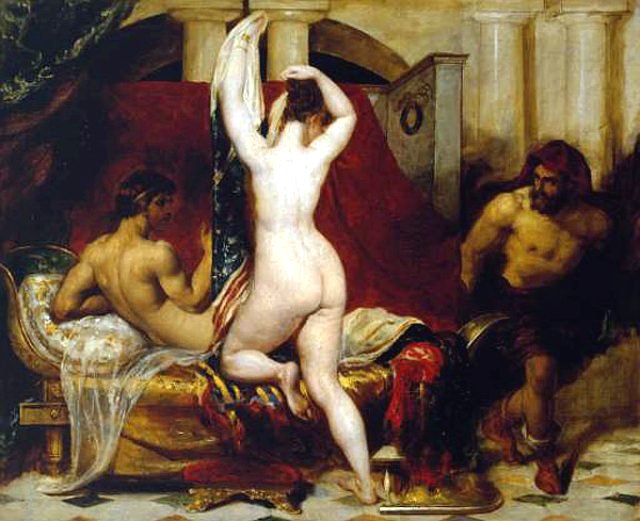
A couple of weeks ago I travelled to York and visited the city’s art gallery which had a long-running exhibition of the works of William Etty. William Etty was born and died in the city and therefore he is the pride and joy of the city’s artistic community. However as we will see in this blog, Etty’s work was often very controversial.
William Etty’s father, Matthew, was a miller and his mother, Esther Calverley, was the sister of the Squire of Hayton, Matthew was aged 28 and Esther just 17 when they fell in love in Hayton and then quickly married at All Saints Church, Pocklington, in July 1771. But Esther’s brother was highly disapproving of his young sister’s marriage, and as lord of the manor, who owned both the mill and the milling rights in Hayton, he promptly ejected Matthew and his new wife from the mill, which was their home, and the newlyweds were ‘run out of town’.
They moved to Pocklington and set up a bakery business, but it did not take off, which may have been due to the wider influence in Pocklington of the squire. The young couple moved briefly to Easington, then made a final switch to York, where their bakery was more successful and Etty’s father again took up flour milling. Alhough they were never particularly well off they produced a large family of ten children, born between 1772 and 1793.
William Etty was born in York in 1787, and grew up in the family bakery. He spent some years at a Pocklington boarding school but in 1798, aged eleven, his father arranged a seven year apprenticeship as a printer at the works of the Hull Packet newspaper. Etty had shown an interest in art in his teenage years and fortunately, through the encouragement and financial support of his wealthy uncle, a successful London gold-lace merchant, he was later able to pursue a career as a painter. His uncle invited Etty to London in 1806 and the following year, aged twenty, he enrolled at the Royal Academy Schools where he studied under Henry Fuseli and received some private tuition from Sir Thomas Lawrence, a painter who influenced Etty’s early works. During this time he would visit the National Gallery in London and study the works of the old masters, especially the Italian masters of the Renaissance. During his time at the Royal Academy he would take part in the Life classes and continued with those studies well after he had became an Academician and well after he had completed all the courses. It was obvious that William Etty was fascinated by the male and female body and its portrayal. I will end Etty’s biography here and conclude it in my next blog.
My Daily Art Display today is entitled Candaules, King of Lydia, Shews his Wife by Stealth to Gyges, One of his Ministers, As She Goes to Bed and was painted by Etty in 1820. The work is based on a story from The Histories of Herodotus, one of the most influential works of history in Western literature. The nine-volume work was written between 450BC to 420BC and records ancient traditions, politics, geography, and clashes of various cultures that were known around the Mediterranean and Western Asia at that time. In the first volume there is the story of King Candaules who according to the tale bragged of his wife’s incredible beauty to his favourite bodyguard Gyges. “It appears you don’t believe me when I tell you how lovely my wife is,” said Candaules. “A man always believes his eyes better than his ears; so do as I tell you – contrive to see her naked.”
Gyges refused; he did not want to dishonour the Queen by seeing her nude body. He also feared what the King might do to him if he did accept. However Candaules was insistent and Gyges had no choice but to obey. Candaules detailed a plan by which Gyges would hide behind a door in the royal bedroom to observe the Queen disrobing before bed. Gyges would then leave the room while the Queen’s back was turned. That night, the plan was executed. However, the Queen saw Gyges as he left the room, and recognized immediately that she had been betrayed and shamed by her own husband. She silently swore to have her revenge, and began to arrange her own plan. The next day, the Queen summoned Gyges to her chamber. Although he thought nothing of the routine request, she confronted him immediately with her knowledge of his misdeed and her husband’s. “One of you must die,” she declared. “Either my husband, the author of this wicked plot; or you, who have outraged propriety by seeing me naked.” Gyges pleaded with the Queen not to force him to make this choice. She was relentless, and eventually he chose to betray the King so that he should live.
The Queen prepared for Gyges to kill Candaules by the same manner in which she was shamed. Gyges hid behind the door of the bedroom chamber with a knife provided by the Queen, and killed him in his sleep. Gyges married the Queen and became King, and father to the Memnad Dynasty.
Before us we have a scene from the start of the tale in which we see Gyges creeping stealthily into the bedroom to catch a glimpse of the naked queen.
Looking through comments made by art critics of the day I came across one who described the subject of the painting as:
“ an undeniably disagreeable, not to say objectionable subject…”
Other reviewers called it
“…offensive, reprobate and a disgraceful story with debase sensuality…”
So what do you think? Beautiful or distasteful?
